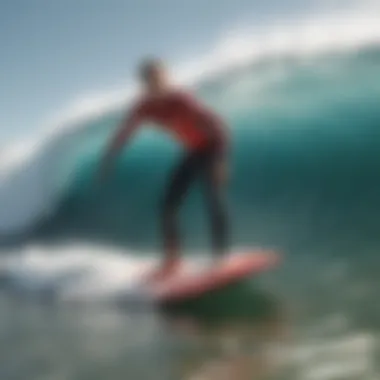Exploring the 7ft Foamie Surfboard: A Complete Guide


Intro
The 7ft foamie surfboard has carved a niche in the hearts of surfers, from eager novices to seasoned wave riders. With a design that combines ease of use and stability, these boards are making waves—pun intended— in the surfing community. This guide will peel back the layers of this unique piece of surfing equipment, offering insights into its construction, usability, and the myriad benefits it provides.
Foamies, as they are colloquially known, are often regarded as the perfect entry point into surfing. Their buoyant structure makes catching waves a breeze, while their forgiving materials cushion the falls that inevitably come with learning. But foamies are not just for beginners; they’re also favored by experienced surfers looking for a laid-back session or those navigating small, playful surf.
In our extensive exploration, we will delve into the various techniques for mastering your foamie, the essential equipment you may need, and tips on maintaining your board to ensure longevity. Moreover, we will touch on important environmental considerations, as surfers today are increasingly mindful of their impact on the ocean, making it crucial to select eco-friendly gear.
This guide strives to offer a rounded perspective to anyone considering a 7ft foamie surfboard for their next ocean adventure. Let's dive in.
Foreword to the 7ft Foamie Surfboard
The 7ft foamie surfboard holds a special place in the hearts of surfers ranging from eager beginners to seasoned surfers. Its design offers a unique blend of convenience, safety, and performance that caters to a diverse range of skills and experiences. In an increasingly crowded surf scene, understanding this surfboard becomes crucial for anyone looking to navigate the waves with confidence.
First and foremost, the foamie is aptly designed for stability. Unlike traditional boards, which may cause initial wobbling, the wider design and lighter material of the foamie provide a solid foundation. This stable design makes it easier for novices to stay on their feet, promoting a quicker learning curve. Picture a child learning to ride a bike; the training wheels offer that essential support. Similarly, foamies serve a purpose beyond just being buoyant—they provide a sense of security.
Additionally, foam surfboards come with inherent safety benefits. The soft exterior reduces the risk of injuries, making it less intimidating for new surfers who may be hesitant in the water. This softness can be particularly forgiving during those inevitable wipeouts. The thought of hitting a hard fiberglass board can paralyze even seasoned surfers, so a foamie eases those worries.
Moreover, the versatility of the 7ft foamie cannot be understated. It serves not just as a learning tool but as a practical option for experienced surfers looking to enjoy mellow days on the water or practice smaller tricks without the pressure associated with fiberglass boards. It's not unheard of for seasoned surfers to pull a foamie off the rack on a day meant for fun rather than fierce competition.
"The 7ft foamie is like a trusty pair of sneakers. It’s about comfort, safety, and the freedom to explore without the overhang of pressure."
In essence, diving into the world of foamies opens up a treasure trove of opportunities. For instructors, these boards are invaluable teaching aids, ensuring that students can make mistakes without the steep penalties that often accompany traditional boards. For the eco-conscious adventurer, there are options that focus on using responsibly-sourced materials, echoing a broader movement within the surfing community towards environmental awareness.
The 7ft foamie surfboard is more than just a piece of equipment; it's an entry point into a lifestyle that embraces the exhilarating dance of wave riding while fostering a supportive community. As the article progresses, we will delve deeper into foamies—how they’re made, their benefits, and why they stand out in the sea of surfboards.
Understanding Foamies
Foam boards, particularly the 7ft foamie surfboard, are becoming increasingly popular among surfers of all skill levels. Understanding foamies is crucial for anyone looking to navigate the wave-riding waters effectively and safely. Their design and construction make them a viable option for novices to seasoned surfers alike, offering benefits that traditional boards may not provide.
Notably, foamies are designed to create a safer surfing experience, ensuring both the rider and those around them are less exposed to injury during wipeouts. This aspect of foamies can’t be overlooked, especially in crowded surf spots. Beyond safety, they're also user-friendly, allowing beginners to feel more confident on the water. The buoyancy of the 7ft foamie helps surfers maintain stability while they learn paddling, positioning, and turning. These characteristics make this type of surfboard an ideal training tool when gaining experience in the surf.
Definition and Purpose
A foamie surfboard, like the 7ft variant, is typically constructed from soft foam materials, which contribute to its lightweight nature and flex. This design serves several purposes. First, the soft top minimizes the risk of injuries during accidental falls, making it a perfect choice for beginner surfers. Secondly, foam boards are generally broader and have more volume than traditional fiberglass boards. This means they float better, providing stability to those still mastering their balance. Additionally, these boards are made to absorb some impact—ideal for choppy water conditions or those rolling waves that can throw a surfer off balance unexpectedly.
The 7ft foamie, specifically, strikes a balance between maneuverability and floating capacity, catering to a wide range of surfing techniques. It is not only suitable for beginners learning the ropes but also serves intermediate surfers eager to advance their skills. Essentially, foamies combine fun and safety, allowing surfers to enjoy their time on the water without hesitation.
Common Misconceptions
Despite the growing popularity of foamies, various misconceptions surround them. Many surfers regard foam boards as inferior to fiberglass boards. However, this opinion largely stems from ignorance about the evolving designs and technologies in foam construction. Foam boards have been innovatively tailored to meet diverse surfing needs. They are not just for kids or those entirely new to the sport.
Another common misconception is that foamies lack performance. While traditional boards often aim for speed and agility on the waves, foamies are engineered to help surfers improve their technique. They can be responsive and allow for significant creativity in how one rides waves. Moreover, some believe foam boards are limited to smaller waves, yet many experienced surfers have found that with the right technique, they can handle larger swells just as effectively—provided the surfer understands the limitations of the board.
In summary, understanding foamies plays a pivotal role in enhancing the surfing experience. Recognizing their purpose and debunking common myths empowers surfers to embrace foamies as versatile tools that enrich their skills and enjoyment on the water. \n
"A good surfboard is like a great pair of shoes—comfort and fit can change your whole experience!"
Those looking to explore the potential of a 7ft foamie surfboard can discover a world where fun and safety coexist, paving the way for new adventures in surfing.
Construction of the 7ft Foamie
Understanding the construction of a 7ft foamie surfboard is crucial not just for its performance but also for the way it serves various categories of surfers, from novices to seasoned pros. The craft of foam boards goes beyond simple assembly; it’s about striking a balance between durability and user-friendliness. Craftsmanship plays a significant role, as it affects the board's responsiveness in the water, stability while paddling, and overall lifespan.
Materials Used
The choice of materials in the construction of a 7ft foamie is fundamental. Most foam surfboards are primarily made from expanded polystyrene (EPS) foam, which is lightweight yet surprisingly strong. This allows for easier handling both in and out of the water. On the surface, a layer of soft polyurethane foam provides a cushy feel, reducing the risk of injury for beginners and kids. Some models incorporate a core of fiberglass or epoxy for additional strength without adding unnecessary weight. This layered approach not only enhances the board’s robustness but also simplifies repairs down the line.
Furthermore, many manufacturers are stepping up their game by implementing eco-friendly materials, such as sustainable resources for the inner core and biodegradable foams. As eco-conscious surfers become more prevalent, these greener options align with their values, allowing them to enjoy the waves without guilt.


Design Features
The design of a 7ft foamie surfboard is intrinsically linked to its functionality. Most boards come equipped with a wide tail and a fuller outline, which enhances stability. This is especially helpful for beginners learning to paddle and balance. The bottom contourings, often featuring a single or a slight triple concave, provide a unique combination of speed and maneuverability.
Another critical design aspect is the weight distribution across the board. Well-designed foamies ensure that weight is evenly distributed, so it doesn't tip over easily. Furthermore, the inclusion of strategically placed fins, typically fins made from flexible plastic, helps in enhancing control when turning. Some advanced models allow for removable fins, offering versatility depending on the surfing conditions.
In terms of aesthetics, foamies often come in a variety of bright colors and patterns, making them appealing to a younger demographic. This visual appeal may not affect performance directly, but it certainly adds a flair that resonates with surf culture.
"Good surfboards come from a good foundation. Materials and design can either help you ride the waves or fight them; choose wisely."
Overall, the construction of the 7ft foamie is a fine interplay of material science and design specialization, creating a board that meets the versatile demands of every surfer. Understanding these elements allows prospective buyers to better appreciate what lies beneath the glossy finish of their foamie.
Advantages of Using a 7ft Foamie
The 7ft foamie surfboard has become a beloved choice among various groups of surfers for multiple reasons. It's more than just a tool for riding waves; it's a stepping stone into the world of surfing for many and a versatile board that suits seasoned surfers looking for a relaxed session. Understanding the key advantages of this foamie can help you appreciate its role in the sport.
Safety Benefits
One of the standout features of a 7ft foamie is safety. With a softer foam construction, the risk of injury is significantly minimized. Unlike hard fiberglass boards that can potentially cause serious harm during collisions, foamies offer a much gentler approach. This aspect makes them perfect for beginner surfers who might wipe out often. Additionally, the buoyant design reduces the chances of the board submerging deeply, ensuring it pops back up quickly after tumbles, which can alleviate fears for newcomers wobbling on their first waves.
"For beginners and those who have been out of the water for a while, the foamie lets you focus on enjoying the ride rather than worrying about bruises or bumps. The buoyancy and soft edges are an added comfort that makes the experience enjoyable."
Stability and Buoyancy
When it comes to stability, the 7ft foamie shines brightly. The wider shape and increased volume contribute significantly to how stable the board feels on the water. As the waves roll in, a foamie provides confidence to novice surfers. The ample buoyancy helps keep even those who are less experienced feeling anchored, allowing for a smoother ride while learning to balance and paddle.
This enhanced stability also serves intermediate surfers who want to progress their skills. They can practice tricks, turns, or even just refine their paddling in a more forgiving environment, without the constant fear of falling into the water. Surfing becomes less of a chore and more of an enjoyable experience – and that’s something every rider appreciates.
Ease of Use for Beginners
Let’s face it: starting out in surfing can feel like trying to ride a bull in a rodeo. The 7ft foamie makes this introductory phase less daunting. Its lightweight design allows beginners to maneuver it more easily in the water. Unlike heavier boards, which can be frustrating and exhausting to handle, a foamie glides along the surface without taxing your energy reserves. The combination of size and lightweight feel gives newcomers a better sense of control, making it easier to catch waves.
Moreover, beginners can focus on mastering basic techniques such as paddling and popping up without being overwhelmed by complicated maneuvers. As they gain confidence, the transition to more advanced boards becomes smoother, as they've already cultivated essential skills on a user-friendly platform.
In summary, the advantages of using a 7ft foamie aren't just about convenience; they create a supportive environment for surfers of all levels. From safety to stability and ease of use, foamies present an appealing blend of features that cater to a broad audience, ensuring waves are ridden with smiles instead of worries.
Target Audience for Foamies
Understanding the target audience for 7ft foamie surfboards is crucial because it shapes not only the design and marketing approaches but also the overall functionality of the boards. Each group possesses distinct needs and levels of expertise that can influence their choice of surfboard. By recognizing the differences among beginners, intermediate surfers, and surf instructors, manufacturers can ensure that the boards are tailored to maximize fun and safety on the water.
Beginners and Casual Surfers
For newcomers to surfing, the 7ft foamie surfboard acts like a friendly companion. It's designed for those who may be a bit timid about crashing into waves or losing their balance. The buoyancy that foam provides allows beginners to build skills without the worry of serious injury. A common barrier for many hopeful surfers is the fear of falling; cushioning is key. The soft foam surface mitigates impacts, so when beginners take a tumble, they are less likely to get hurt.
Moreover, beginners are often looking for a board that is easy to paddle and stable. The size and weight distribution of the 7ft foamie lend themselves well to those who might not yet be incredibly strong or agile. This makes catching waves less of a daunting task and more a rewarding experience. A seamless introduction to the sport is vital. Ultimately, foamies foster confidence in tackling waves, creating a more enjoyable and less intimidating entry into surfing.
Intermediate Surfers Looking to Progress
As surfers gain experience and feel more comfortable, they often look to refine their skills. The 7ft foamie can be a valuable tool for this group too. While they may have graduated from using basic soft-top boards, these foamies present a perfect blend of playfulness and performance. For intermediate surfers, particularly those wanting to work on their turning techniques or board control without the fear of cracking a fiberglass board, foamies offer a safe playground.
They can practice new maneuvers without the immediate stress of damaging an expensive board. Additionally, some surfers appreciate the adaptability of foamies in smaller, softer conditions. They allow for creative expression on the waves, making it easier to experiment with different surfing styles.
Surf Instructors and Schools
For surf instructors and schools, 7ft foamie surfboards represent a safe and effective teaching tool. When guiding novices through the waves, instructors need boards that ensure safety while still providing a platform for learning. The forgiving nature of foamies fosters an environment that encourages experimentation, making the learning process smoother.
Instructors can confidently let their students ride these boards without apprehension about injuries. Additionally, dive schools often face challenges regarding board durability under heavy use. Foam boards stand up well to the rigors of teaching, maintaining their usability through numerous lessons and crashes. Furthermore, the lightweight design makes handling easier for instructors, allowing them to focus more on student progression rather than the logistics of equipment management.
Ultimately, the target audience for 7ft foamie surfboards spans a wide range. Whether a beginner learning the ropes, an intermediate surfer honing their skills, or an instructor guiding the next generation of surfers, foamies deliver value in various forms. This versatility highlights why foamies continue to play a significant role in the surfing landscape, providing accessible enjoyment for many.
Techniques for Using a 7ft Foamie


Understanding how to manipulate a 7ft foamie surfboard can greatly enhance the experience in the water. Whether you're just dipping toes into the surf or you're fine-tuning skills, focusing on specific techniques will ensure you ride those waves with confidence.
Paddling Techniques
Paddling is the first step in catching a wave, and doing it right can be the difference between gliding smoothly or missing out entirely.
- Body Positioning: Lie down on the board with your chest centered. Your toes should hang slightly over the back, ensuring the board is balanced. It's similar to making sure a seesaw is equally weighted; otherwise, you risk tipping over.
- Arm Movement: Use an alternating motion with your arms, similar to a freestyle swim. Keeping strong strokes helps propel you forward faster. If you aren't moving, you’ll find yourself getting pushed back by the waves, which can be quite infuriating.
- Breath Control: Keeping your head in a natural position can aid your paddling. Try to engage your core while paddling for better stability. Remember the old adage: "work smarter, not harder."
Positioning and Balancing
Finding your balance on the board is the key to riding waves. Here's how to nail it:
- Knee Position: Start by positioning your knees slightly behind the center point of the board. This will give you leverage when it's time to stand up. Think of it like creating a stable foundation for a house.
- Standing Up: When you see a wave approaching, push up from your knees to standing position smoothly. Try to keep your feet hip-width apart. Placing them too close together can cause instability.
- Center of Gravity: Lower your hips, bending your knees a bit more to keep your center of gravity low. You might feel wobbly at first; that’s okay. With practice, it will feel natural.
Turning and Maneuvering
Once you’ve mastered paddling and balancing, turning becomes your next skill to conquer. A few critical elements can make turning a breeze:
- Weight Distribution: Shift your weight towards the direction you want to go. If you intend to turn right, lean a bit towards your right foot. It's akin to leaning into a curve when riding a bike.
- Use Your Shoulders: Initiate the turn by looking in the direction you wish to maneuver. Your body will naturally follow. This can be beneficial, especially in tight situations when quick reflexes are required.
- Practice Carves: Once you're comfortable, practice carving turns by staying low and pushing through your back foot. You’ll almost feel like you're drawing lines on that wave, creating a more fluid motion.
"The balance of a good surf ride lies in your ability to adjust quickly, adapting to the rhythm of the ocean."
By honing these techniques, your journey on the 7ft foamie can transform from tentative paddles to composed rides. It’s all about practice and, most importantly, having fun on the waves.
Maintaining Your 7ft Foamie Surfboard
When it comes to enjoying those perfect waves, having a well-maintained surfboard is essential. The 7ft foamie surfboard stands out not just for its user-friendly design but also for its resilience. Yet, like any piece of equipment, it requires a bit of TLC to ensure it serves you well over time. Proper maintenance can prolong its life and enhance your surfing experience, making it not just a good investment but a smart one too.
Cleaning and Care
Keeping your foamie clean isn’t merely about aesthetics; it's about performance and longevity. Saltwater, sand, and sunscreen residues can accumulate and affect the surfboard's integrity. Here are a few key cleaning practices:
- Wash After Use: After every session, rinse your foamie with fresh water. This removes salty residue that can damage the board over time.
- Use Mild Soap: For a more thorough cleaning, use a mild soap with a soft sponge. Avoid harsh chemicals as they might degrade the foam.
- Drying: Air dry your board completely before storing it. Leaving it wet can lead to mold or mildew growth, which is a real pain to deal with later.
By adopting these cleaning habits, you're not just preserving the visual appeal; you're maintaining buoyancy and stability, ensuring your board feels as good as new for every ride.
Repairing Minor Damages
Despite their durable nature, foamies can occasionally suffer minor damages from typical wear-and-tear or an unwelcome collision with rocks or other surfers. Addressing these issues promptly is key to preventing bigger problems down the line. Here’s how:
- Inspect Regularly: Regular checks for dents, scratches, or cracks can spot minor damages before they worsen.
- DIY Repairs: For small dings, you can use a repair kit specifically designed for foam boards. These typically include foam patches and adhesives that are easy to apply.
- Professional Help: If the damage is extensive, seeking a professional repair service is advisable. They have the right materials and expertise to ensure your board is restored correctly.
Taking care of these minor issues not only keeps your board functional but also prevents further degradation that could affect your surfing experience.
Storing Your Foamie Properly
Where and how you store your 7ft foamie can make a world of difference in its longevity. Improper storage can warp the shape or lead to unnecessary wear. Here are some storage tips:
- Avoid Direct Sunlight: Prolonged exposure to sunlight can degrade the foam and colors of your surfboard. If you can, keep it in a shaded place or cover it when not in use.
- Vertical Storage: Store your board vertically if possible, as this prevents it from getting bent or warped.
- Use a Board Bag: Investing in a good quality board bag not only offers protection from dings but also shields it from UV rays and dust.
Maintaining your surfboard, cleaning it properly, fixing minor defects promptly, and storing it correctly are all simple ways to ensure that your 7ft foamie remains in excellent condition for many waves to come. After all, a happy board equals happy surfing.
Environmental Considerations
When discussing surfboards, especially the 7ft foamie, it’s essential to peek beyond the waves and delve into the environmental implications that their production and disposal present. The surfing community has begun to recognize the urgent need for sustainability in all areas, from the materials used in board construction to the lifecycle of the surfboards themselves. This section aims to spotlight critical environmental considerations that accompany foam surfboards, alongside their potential benefits.
Sustainable Materials in Foamies
In an age where eco-consciousness is gaining traction, foam surfboards are not simply functional tools for catching waves; they can also serve as examples of sustainability. Many foamies now feature materials that minimize environmental impact. For instance, manufacturers are starting to adopt plant-based foams or recycled materials, which not only reduce reliance on harmful petrochemicals but also lessen the carbon footprint of production.
- Plant-based Foams: Some foam surfboards are now crafted from bio-resins derived from plants, which replace traditional petroleum-based foams.
- Recycled Materials: Certain brands experiment with incorporating recycled plastics, contributing to a reduction in ocean pollution while creating functional boards.
- Durability: New production methods are also focusing on longevity. A more durable surfboard means fewer boards are discarded over time, which is a win-win for the surfers and the planet.


Utilizing sustainable materials not only helps the planet but also appeals to environmentally-minded surfers who are eager to contribute positively to the ecosystem they love.
Recycling Options for Old Boards
As surfers progress, they often accumulate a collection of boards, and unfortunately, many of those end up in landfills. The good news is that options for recycling and repurposing old boards are emerging. In an effort to combat waste, surfers can consider a few practical routes:
- Donate: Many local surf schools or youth programs are often happy to accept donated boards, providing budding surfers with affordable tools to learn the craft.
- Repair: Instead of tossing a damaged board, consider taking it to a skilled repair service. Small imperfection don't have to signal the end of its life.
- Recycling Programs: Some brands are taking the lead by establishing recycling programs where old boards can be returned and repurposed. For example, certain surf shops or companies might offer an exchange for new boards.
"The ocean holds our passion and dreams; maintaining it is our duty."
By actively engaging in recycling initiatives and considering the longevity of surfboards, surfers can help ensure that their beloved sport doesn’t come at the expense of the environment. This proactive mindset aligns with a broader shift towards reducing plastic waste in the surfing culture.
Comparing Foamies with Other Board Types
The choice of surfboard significantly impacts a surfer’s experience on the waves, influencing everything from stability to performance. In this section, we’ll dig into how foamies stack up against traditional boards, like fiberglass, providing insights into the unique advantages and potential drawbacks of each type. By understanding these distinctions, surfers can better determine what best suits their style, skill level, and environmental beliefs.
Foam vs. Fiberglass Boards
Foam surfboards, particularly the 7ft foamie, present a softer alternative to their fiberglass counterparts. One of the most noticeable differences is in their construction materials. Foam boards, made predominantly from polystyrene or polyurethane foam, offer a lightweight and durable build, while fiberglass boards are created using layers of fiberglass cloth and resin which results in a rigid but heavier structure. Here’s a snapshot of how they differ:
- Weight: Foamies are generally lighter, making them simpler to maneuver, especially for beginners. This can encourage a more natural learning curve.
- Safety: Given their softer composition, foam boards are less likely to cause injury when thrown around in the water. Fiberglass boards tend to have sharper edges which can lead to mishaps.
- Durability: Foam surfboards can withstand a fair bit of rough treatment. However, while they can take a pounding, they may not last as long under aggressive use compared to fiberglass boards that, while susceptible to dings, can be repaired easily.
- Cost: Generally speaking, foamies can be less expensive than fiberglass boards, making them appealing for those just trying their hand at surfing without a hefty financial commitment.
Performance Differences
When it comes to performance, the gulf between foam and fiberglass can be more than just construction. Each type of board has its own characteristics that can suit different surfing styles or conditions:
- Ride Feel: Foam boards tend to have a more forgiving ride. This can enable novices to catch waves more easily. In contrast, fiberglass boards tend to provide better speed and responsiveness but require more skill to navigate effectively.
- Wave Conditions: Foamies perform well in smaller waves due to their buoyancy and stability. Fiberglass boards excel in larger or more challenging conditions, where quick turns and speed become vital.
- Learning Curve: Beginners may find foamies much easier to get used to, as they provide greater stability and support, promoting a positive experience while learning. On the other hand, fiberglass boards might suit intermediate and advanced surfers who have already honed their balance and techniques.
"Every surf session is a new lesson. Choose a board that complements your current skill and challenges you to grow."
Future Trends in Foam Surfboards
As we look ahead, the landscape of foam surfboards, particularly the 7ft foamie, continues to evolve. This shift isn’t just about aesthetics or performance but reflects broader trends within the surf industry. Understanding these changes is essential for surfers, instructors, and eco-enthusiasts alike as it provides insight into what the future holds for these popular boards.
Innovations in Foam Technology
The foam surfboard market is witnessing remarkable innovations. Manufacturers blend traditional materials with cutting-edge technology to enhance durability and performance. For instance, the incorporation of biodegradable foams is gaining traction. These materials offer the same buoyancy and stability as conventional foam but with reduced environmental impact.
Additionally, there's experimentation with lightweight composite materials that improve responsiveness while maintaining that soft, forgiving surface that foamies are known for. A notable example is the integration of recycled materials into the foam mix, presenting not just a performance upgrade but also a conscious effort towards sustainability.
"The surfboard industry is at a crossroads where creativity meets responsibility, creating boards that surf better and are better for the planet."
Surfers are also witnessing advancing manufacturing processes, like 3D printing, allowing for customizations that cater to individual weight, height, and skill levels. Personalized foamies based on individual needs will likely become a norm rather than exception, making the sport more accessible and enjoyable for diverse populations.
The Growing Popularity of Foamies
Foam surfboards, particularly the 7ft variation, are seeing an upswing in popularity, and that's not by accident. With the surf culture becoming increasingly inclusive, foamies are at the forefront of this movement. Their reputation as user-friendly boards has made them staples in surf schools and among families heading for beach days.
- The gradual shift from traditional boards to foamies is primarily evident among beginner surfers who appreciate their stability and safety.
- As more people turn to surfing for recreation, the relaxed approach that foam boards offer is appealing. Many seasoned surfers are also adopting foamies for casual sessions, valuing their ability to catch waves with light-hearted ease.
Moreover, events promoting the use of foamies are becoming more frequent, fostering a community that champions these boards as more than just beginner tools. As surfers discover that they can enjoy a premier surfing experience on foamies, word spreads, leading to a growing acceptance and excitement surrounding foam technology.
Consequently, foam surfboards are not just enjoying a moment in the sun—they are heralding a significant shift in surfing culture and practices, shaping a future that embraces diversity and sustainability in the sport.
The End
In concluding our exploration of the 7ft foamie surfboard, it becomes evident that this piece of equipment offers a unique blend of benefits tailored to various skill levels. For novices, it serves as a welcoming entry point into the world of surfing. The inherent stability and buoyancy provided by the foam construction allow beginners to gain confidence quickly. As they glide over gentle waves, the foamie's forgiving nature minimizes frustration, offering a smoother learning curve.
For intermediate surfers keen on refining their skills, the 7ft foamie acts as a versatile platform. It presents an opportunity to practice advanced techniques and maneuvers in a safe environment. This adaptability makes it a valuable companion while progressing toward more challenging boards.
Moreover, surf instructors appreciate the 7ft foamie not just for its safety features but also for its durability. A board that can withstand the rough and tumble of lessons, it allows instructors to focus on teaching without worrying about constant repairs due to wear and tear.
Environmental implications also play a vital role in the foamie discourse. With a growing trend towards sustainable materials, considering the ecological impact of surfboards is becoming increasingly important. Many foamies nowadays are designed with eco-friendly materials, emphasizing the need to protect the waves we cherish.
"Choosing a foamie isn’t just about ease; it aligns with our responsibility towards nature and the community. "
Finally, as we look forward to future trends in the surfing industry, it's clear that the popularity of foam boards is on the rise. Innovations in foam technology will continue to enhance their performance and environmental footprint, advocating for a surfing lifestyle that respects both the ocean and its enthusiasts. In sum, the 7ft foamie surfboard stands out not simply as a tool for surfing, but as a symbol of progression, safety, and sustainability in our beloved sport.















